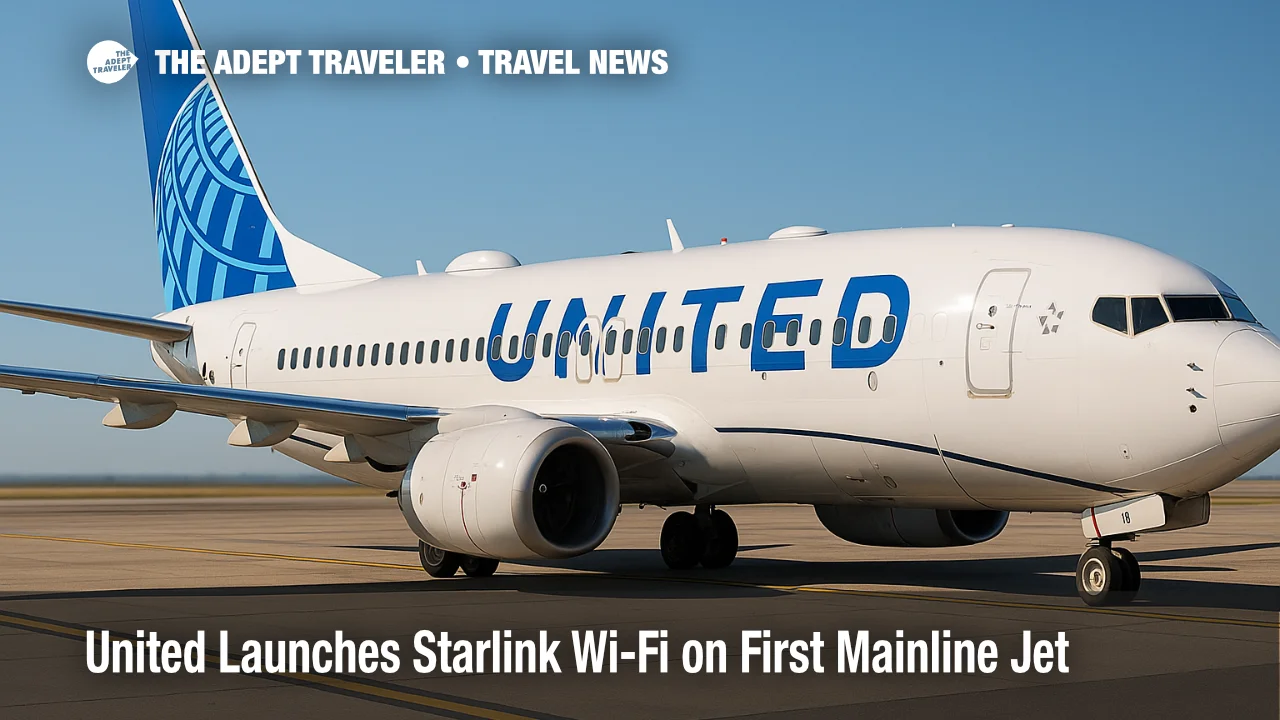United launches Starlink Wi-Fi on first mainline jet

United's first Starlink-equipped mainline aircraft, a Boeing 737-800, is set to fly United 2940 from Newark Liberty International Airport (EWR) to George Bush Intercontinental Airport (IAH) at 8:00 a.m. ET on October 15 with more than 170 customers onboard. The same aircraft is scheduled to continue Houston to Fort Lauderdale-Hollywood International Airport (FLL) as United 365, then return to Houston as United 445. United says Starlink will be free for MileagePlus members and available on both personal devices and seatback entertainment screens, with plans to add about 15 mainline aircraft per month.
Key points
- Why it matters: Faster, low-latency Wi-Fi enables streaming, live sports, and real-time work in flight.
- Travel impact: Free access for MileagePlus members, gate-to-gate connectivity, and support across multiple devices.
- What's next: United targets another mainline aircraft type certification before 2026, scaling monthly installs.
- Install plan calls for two antennas per 737-800 and thousands of antennas fleetwide.
- United says more than half of its regional jets already offer Starlink.
Snapshot
United is the first major U.S. airline to activate Starlink on a mainline flight with connectivity to both personal devices and seatback screens. Flight 2940 will debut the system between Newark and Houston on October 15, with same-day turns to and from Fort Lauderdale. The airline will install two Starlink antennas per 737-800 and expects to equip roughly 15 mainline aircraft each month. Access is complimentary for MileagePlus members, aligning with United's strategy to pair fast, low-latency satellite internet with its growing seatback footprint. United reports strong satisfaction scores on already-equipped regional jets and intends to expand Starlink fleetwide in phases as additional certifications are secured.
Background
Starlink, SpaceX's low Earth orbit broadband network, has accelerated the in-flight connectivity race with lower latency and ground-like speeds. JSX and Hawaiian Airlines were early U.S. adopters, with Hawaiian debuting Starlink in February 2024 on Airbus A321neo routes and later expanding across its Airbus fleet. United announced its Starlink partnership in 2024, then advanced its timeline to begin regional service in spring 2025 and pursue mainline certification later the same year. The Federal Aviation Administration approved United's first Starlink-equipped mainline 737-800 in late September 2025, clearing the path for the October 15 debut. United positions this as the first U.S. mainline activation that integrates Starlink across both seatback entertainment and personal devices, differentiating it from earlier rollouts on aircraft without seatback screens.
Latest developments
Installations begin on Boeing 737-800s with seatback integration
United says its first Starlink mainline operation will cover personal devices and seatback entertainment screens on the Boeing 737-800, enabling live TV, streaming video, real-time collaboration, and gaming with minimal buffering. The airline plans to install two antennas per aircraft and scale installations to about 15 mainline planes monthly. More than half of United's two-cabin regional fleet already has Starlink, and the airline reports high customer satisfaction tied to streaming performance and ease of use. MileagePlus members will receive complimentary access, and United will notify customers when their flights are Starlink-equipped. The carrier expects one additional mainline aircraft type to be certified before 2026, further expanding the program as hundreds of new and retrofitted aircraft add or enhance seatback screens.
Analysis
United's Starlink debut on a mainline jet, and specifically its integration with seatback entertainment, represents a meaningful competitive step in U.S. domestic connectivity. While Hawaiian Airlines launched Starlink on mainline aircraft earlier, United's emphasis on simultaneous delivery to both seatback systems and personal devices aligns with its broader cabin strategy, which includes expanding seatback screens across the fleet. The choice of the 737-800 for the first activation should accelerate coverage on high-frequency domestic routes, where reliable connectivity is a key satisfier for business and leisure travelers alike. Free access for MileagePlus members reduces friction and may lift program sign-ups, engagement, and ancillary revenue tied to shopping and media partnerships. Operationally, two antennas per aircraft and a 15-per-month cadence suggest a measured but steady ramp constrained by certification, installation slots, and parts flow. If performance mirrors regional-jet results, Starlink could reset traveler expectations around streaming, live events, and remote work aloft, increasing pressure on rivals that rely on legacy geostationary systems or mixed fleets.
Final thoughts
United's first mainline Starlink flight is an inflection point for U.S. in-flight connectivity, pairing LEO bandwidth with seatback integration and free access for MileagePlus members. As installations expand on Boeing 737-800s and beyond, travelers should see faster log-ins, fewer pauses, and real productivity from gate to gate. The next certification, expected before 2026, will determine how quickly coverage extends across more cabin layouts. For frequent flyers, route selection may start to favor aircraft that advertise live streaming and real-time collaboration, particularly on longer domestic legs. Watch how competitors respond, as United leans into a connected-cabin strategy centered on United Starlink Wi-Fi.
Sources
- United schedules first Starlink-equipped mainline flight for take off, United Airlines via PR Newswire
- United receives FAA certification for first Starlink-equipped mainline aircraft, United Newsroom
- United gets FAA approval for Starlink internet on Boeing 737-800, Reuters
- United now targets spring 2025 for first Starlink flights, The Verge
- Hawaiian debuts high-speed Starlink internet on select flights, Hawaiian Airlines
- Hawaiian now offering fast and free Starlink Wi-Fi across Airbus fleet, Hawaiian Airlines via PR Newswire
